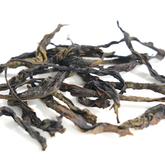Where does tea come from?
All tea in the world can trace its origin back to China, where both the cultivation and consumption of tea began. Tea has a long and rich history in China, with the earliest records dating back to 2737 BCE. According to legend, tea was discovered by Emperor Shen Nong, a mythical figure in Chinese folklore. While boiling water, a tea leaf fell into his pot. As it brewed, the unique aroma attracted his attention, and upon tasting it, he found it not only quenched his thirst but also had a refreshing and invigorating effect. From that moment, tea became a staple beverage and was passed down through generations.

Historical Background
The cultivation and production techniques of tea first developed in China, before spreading to Japan, India, Korea, and other Asian countries. During the Tang Dynasty, tea culture reached its peak, and tea trade flourished. Tea was transported via the Silk Road to Central Asia, West Asia, and eventually Europe. By the 17th century, tea had become a luxury item in Europe, and the British East India Company began importing large quantities of tea to Britain, further driving global tea cultivation and trade.
Green tea is one of the oldest types of tea in China, with a history dating back to 2737 BC during the time of Emperor Shen Nong. Green tea is an unfermented tea, preserving the natural freshness and delicate aroma of the leaves. As early as the Tang and Song dynasties, green tea production methods had become increasingly refined, and famous teas like Longjing and Biluochun emerged. Today, green tea remains the dominant tea in China's tea consumption market.Over time, other tea processing methods were discovered, leading to the development of different types of tea, such as white tea and oolong tea.

Controversy Around the Origin of Tea
While China has thousands of years of documented history and china ancient tea forests to prove its status as the birthplace of tea, there has been controversy. In the 19th century, Britain’s heavy reliance on Chinese tea imports led to trade imbalances. To reduce their dependence on China, British colonists began cultivating tea in their colonies, particularly in India and Sri Lanka, and aimed to control the global tea supply chain. It was during this time that Britain promoted the idea that India was the true origin of tea, which aligned with their strategic shift in tea production. British explorers even traveled to China, secretly learning tea-growing and processing techniques. These methods were then introduced to India, leading to the creation of Assam and Darjeeling teas.
Proof of Tea’s Origins
The most compelling evidence of tea's origin comes from archaeological discoveries and historical records. Archaeologists have uncovered ancient tea seeds and utensils in Southwest China that date back thousands of years. These regions are believed to be the world’s earliest tea-growing areas. Modern research also indicates that these areas are the original habitat of wild tea trees. In Yunnan, ancient tea forests that have existed for thousands of years still remain, further proving that China is the birthplace of tea.

In comparison to other countries' tea plantations, the difference is clear: in many countries, tea plants are densely grown and kept small, primarily because the plantations are younger and designed for easier harvesting. However, tea made from such young, dense plants cannot compare to the tea produced from China’s ancient tea trees, which deliver a vastly superior taste. Additionally, dense, small-scale plantations often require the use of pesticides and fertilizers, as the land cannot provide enough nutrients, which inevitably leads to some level of contamination in the tea.

Moreover, Chinese literature such as the Shen Nong Ben Cao Jing (The Divine Farmer's Materia Medica) and Cha Jing(The Classic of Tea) contain detailed records of tea cultivation, production, and consumption. The Classic of Tea was written by the Tang Dynasty tea master Lu Yu and is the world’s first comprehensive tea book. It covers tea varieties, cultivation methods, processing techniques, tea utensils, and tea ceremonies, making it an essential reference for future generations.
Conclusion
China is undeniably the birthplace of tea, boasting the world’s largest tea cultivation area. Many types of tea, such as oolong tea and white tea, are unique to China. For example, Chinese oolong tea, particularly from Fujian, has a delightful fragrance, while white tea, known for its health benefits, can be stored for long periods. However, despite China's rich tea heritage, the global tea market has often been dominated by the British, and the true value of high-quality Chinese tea has not been fully recognized abroad. This is unfortunate, as Chinese tea, a natural and clean beverage, is truly a marvel.
SEE MORE
If you have questions about selecting tea:
Learn-more-about-chinese-tea
If you have questions about the benefits of tea:
Health-benefits-of-chinese-tea
If you have questions about brewing tea:
How-to-brew-loose-leaf-tea








